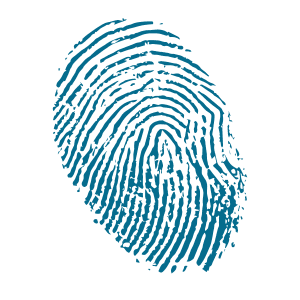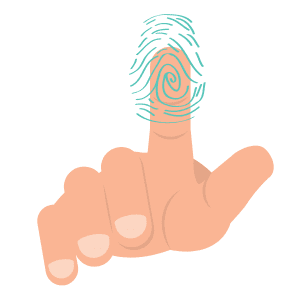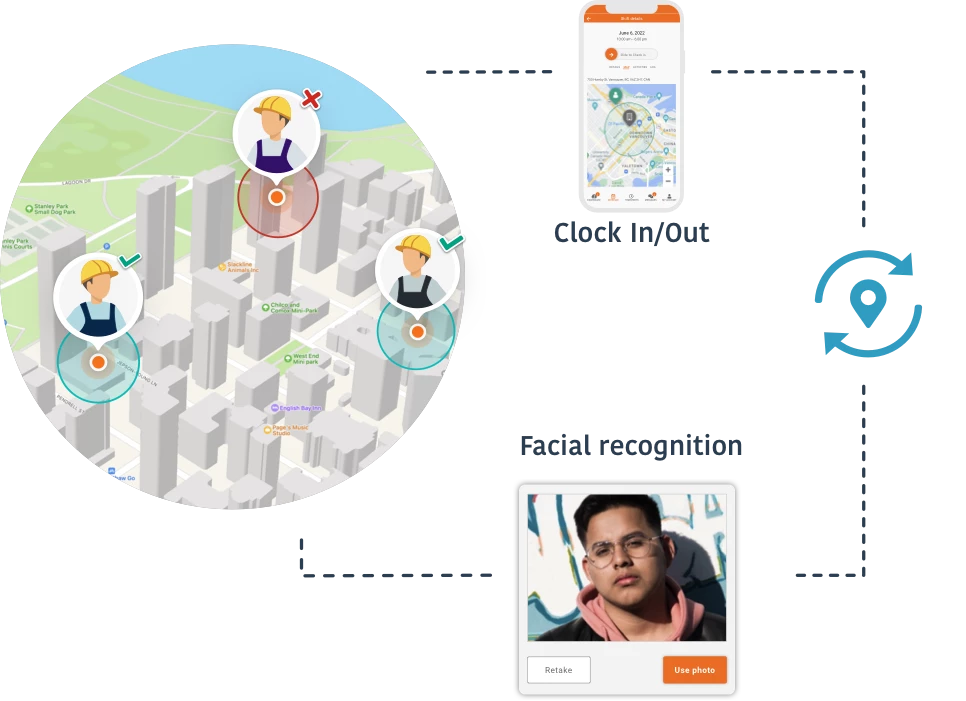Biometric identification is everywhere in our daily lives. From workplaces to airports, face ID, banking, law enforcement – we’ve all come into contact with it recently! We know, it sounds like something out of a science fiction movie!
But there’s a lot that goes into understanding biometric identification. In this blog, we will discuss how biometric identification works. We’ll also look at the advantages of using this software for time and attendance for your business.
What is Biometric Identification?
So, what exactly is biometric identification? Biometrics are strategies for automatically identifying an individual based on physical or behavioural features. There are a lot of types of biometrics available to businesses today. Iris and retina scanning, fingerprint identification, voice recognition, and face and hand recognition are all examples of biometric identification. Biometrics are safer than other methods of confirming someone’s identity. This is because physical traits, such as fingerprints, are typically unique and consistent to each individual.
Biometric Identification For time and attendance
Time and attendance systems are in place to record when employees begin and end their shifts. As part of their workforce management plan, some businesses measure meals and breaks, the sort of work completed, and the number of products generated when employees are not working (e.g. vacation time, compensation time, FMLA time, and jury duty). These records might be kept manually using pen and paper or automatically.
Biometric time and attendance systems are more secure than other systems since there is no need to carry a card or memorize passwords. Because of their numerous advantages, these systems are becoming increasingly popular in today’s market. Also, let’s face it, fingerprint, eye, or facial recognition systems are pretty great.
How can Biometric Identification Improve Time and Attendance
Biometric time clocks eliminate employee time theft.
Employee time theft costs businesses billions of dollars each year. According to the US Department of Commerce, employee dishonesty and time theft cost American firms more than $50 billion each year.
Biometric time clocks are more effective in combatting time theft than security cameras, barcode swipe cards and personal identification numbers (PINs). It also saves money by providing employees with a tangible audit trail and precise monitoring. Buddy Punching, is a familiar time theft problem that biometric identification can solve.
Buddy Punching
One of the most significant advantages of using biometrics for attendance and timekeeping in the workplace is that workers cannot clock in for one another. Time theft may cost some businesses tens of thousands of dollars (or more) every year.
Buddy punching costs businesses in the United States $373 million annually, without adding other forms of time theft. Even top hackers cannot bypass biometric identification! As a result, employees cannot punch in for another coworker when they are absent from the building.
Increased productivity
According to a study, a $5,000 investment in biometric employee time and attendance equipment resulted in a $15,000 annual savings. How? Due to greater productivity and the elimination of buddy punching. This reduced the need for employees to clock in and out and reconcile paper timesheets. This allows for a more fair and balanced allocation of resources to other initiatives that enhance employee productivity.
Reduced administrative costs
Biometrics not only saves employees time by eliminating the need to keep manual records, but it also lowers administrative expenses by:
- Compliance Management: These systems often come with features that help businesses comply with labor laws and regulations, such as overtime tracking and automatic leave accrual calculations. This reduces the administrative workload associated with ensuring compliance.
- Reporting and Analytics: Biometric systems typically offer reporting and analytics tools that provide valuable insights into employee attendance patterns, allowing businesses to make informed decisions and optimize their workforce management strategies without extensive administrative efforts.
- Reduced Paperwork: With biometric systems, there’s less reliance on paper-based timecards or manual record-keeping, which can reduce the administrative burden associated with storing, organizing, and managing physical records.
- Faster Access to Data: Administrators can access attendance data in real-time, enabling quicker response to workforce management needs and reducing the time spent hunting for information.
- Eliminate the need for employee ID cards: Employee ID cards may seem like a minimal cost, but when it comes to larger businesses it can become costly. Lost and damaged cards need to be replaced more frequently than you might think! Biometrics eliminate the need for these cards altogether.
Elimination of Ghost Employees
Every year, governments and businesses waste billions of dollars by paying salaries to non-existent employees falsely registered in the payroll system. You can individually recognize government and commercial personnel using a biometric time clock system. This will prevent duplicate registrations and reduce ghost worker payroll fraud. Moreover, this technology can help establish accountability and punctuality.
Improved Payroll Processes
Biometric identification time and attendance systems offer an automated solution to streamline and enhance the payroll process. This automation ensures precise and real-time data collection, reducing the potential for errors associated with traditional timekeeping methods. Also, the seamless integration of these systems with existing payroll providers facilitates a smoother and more efficient transfer of data.
As a result, businesses can significantly reduce the time and effort spent on payroll administration, ultimately saving money and accelerating payroll processing. The combination of biometric identification and payroll integration not only enhances accuracy but also offers a more convenient and cost-effective solution for managing employee compensation.
What else can the Biometric identification System Do?
When it comes to the workplace, employers may utilize biometric technologies to improve employee experience and workplace security in various ways. Biometrics is an excellent option for building and IT system security too. So, let’s see what all your company can use biometric identification for besides time and attendance tracking!
Logging into company devices
Businesses may eliminate the bother of using PINs and passwords to access PCs or laptops using biometric authentication, making workplace security more convenient and safe. Biometrics are also useful for multi-factor authentication situations, integrating biometrics with a conventional PIN or password-based login.
Restricting and giving access to certain employees
Workplaces often use biometrics to limit employee and non-employee access to certain portions of a facility. For example, all personnel will require access to the building’s entry but not to places storing sensitive information or very vital equipment, such as server rooms.
This also strengthens the security of the building against intruders or guests since they will be unable to reach the restricted sections even if they use their fingerprint to get entrance. Management can assign and remove access from specific employees using the related software for a simple and secure access solution.
Is Biometric Identification Safe?
Biometric identification can be safe and secure when implemented and managed properly, but like any technology, it also comes with its own set of potential risks and considerations. Here are some factors to consider when assessing the safety of biometric identification:
- Data Security: The biometric data collected, such as fingerprints, facial features, or iris scans, should be securely stored and protected. Encryption and strong security protocols are essential to prevent unauthorized access and data breaches. It’s critical to ensure you store biometric data securely.
- Privacy Concerns: Biometric data is highly personal and unique to individuals. Organizations must establish clear policies and obtain informed consent from individuals before collecting and using this personal data. Additionally, they should have robust privacy measures in place to protect this sensitive information.
- Data Accuracy: While biometric identification is generally accurate, it is not infallible. False positives and false negatives can occur, which may lead to authentication errors. Organizations should have mechanisms to address such issues, such as alternative authentication methods.
- Spoofing and Tampering: Biometric systems can be vulnerable to spoofing or tampering attempts, where malicious actors try to use fake or stolen biometric data to gain unauthorized access. To mitigate this risk, biometric systems should incorporate anti-spoofing measures and continuous monitoring.
- Compliance with Regulations: Many countries have laws and regulations governing the collection and use of biometric data, such as the General Data Protection Regulation (GDPR) in Europe or the Biometric Information Privacy Act (BIPA) in Illinois, USA. Organizations must ensure compliance with these regulations to avoid legal consequences.
- System Vulnerabilities: As with any technology, biometric systems can have vulnerabilities that hackers may exploit. Regular security audits, updates, and patches are essential to maintain the security of the biometric identification system.
- User Acceptance: The success of a biometric system also depends on user acceptance. Some individuals may have concerns about using biometrics due to privacy or security fears. Educating users about the system’s security measures and benefits is crucial for fostering trust.
Biometric fingerprint scanners do not save any biometric information that employers may utilize elsewhere. Instead of a full identifying scan, a random collection of data is extracted from the initial image of a user’s fingerprint, which is then encrypted and saved on the device. The original picture is wiped and untraceable.
As a result, biometric systems that function in this manner, such as Celayix’s solution, are fully GDPR compliant and perfectly secure to use.
Integrating biometric identification to track employee time and attendance will result in lower labour and payroll expenditures. Collecting, managing, calculating, and processing timesheet data takes a long time, but firms may boost efficiency and productivity and save money by using an automated biometric attendance time clock.
Biometric identification is a handy security solution because no passwords, badges, ID cards, or paperwork is necessary after implementation. This allows employees to arrive to work fast without worrying about not being checked in because they forgot their access badge.
There is no doubt that biometric time and attendance clocks provide several advantages. While many significant firms and organizations already employ these systems, smaller businesses may benefit from researching them. Using this equipment eliminates employee theft, increases productivity, and has a relatively good ROI.










